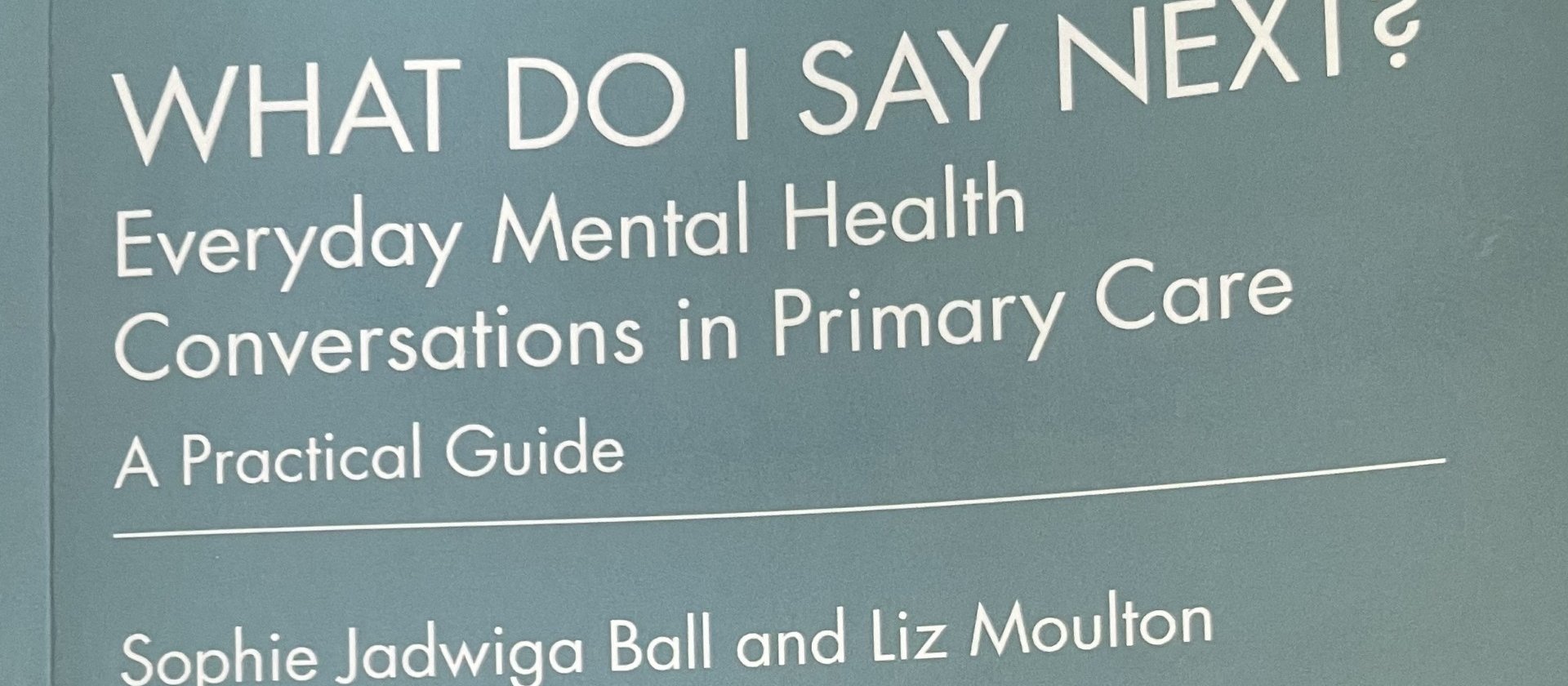Respiratory physician Lutz Beckert considers chronic obstructive pulmonary disease management, including the prevention of COPD, the importance of smoking cessation and pulmonary rehabilitation, and the lifesaving potential of addressing treatable traits. He also discusses the logic of inhaler therapy, moving from single therapy to dual and triple therapy when indicated, as well as other aspects of management
‘Fantastic book’ brims with solutions approach
‘Fantastic book’ brims with solutions approach

Packed with real-life examples and actionable strategies, What do I say next? empowers GPs to have meaningful solutions-based conversations with patients, writes Lucy O’Hagan
What do I say next? Everyday Mental Health Conversations in Primary Care. A Practical Guide by Sophie Jadwiga Ball and Liz Moulton is a fantastic book. I’m very proud of my colleague Sophie for creating a guide that is so practical in helping us answer a very relevant question.
The book is co-authored with GP Dr Moulton, who is well known in the UK for The Naked Consultation: A Practical Guide to Primary Care Consultation Skills (published by CRC Press, 2007). Dr Moulton starts this book with a great consultation summary, including very specific skills for data gathering in the mental health context. She then talks about management in a much broader way than diagnosis, medication and referral to talking therapy. The reader is left with a whole lot of general strategies for responding to mental distress.
Sophie, a specialist GP, is well known in New Zealand. She was the RNZCGP lead medical educator for Auckland South and was also involved in designing the Wellness Support Model of Care, a prizewinning mental health model for use in primary healthcare with Counties Manukau DHB.
Sophie focused on writing the main part of What do I say next? (published by CRC Press, 2024) and it is very different to other books I have read about mental health issues in general practice.
It is practical, based on case examples exploring what might be asked or said, so it feels like real life.
We are given many options, examples of words to say, and simple frameworks for thinking about our approach.
It is not about diagnosis but about how to have a conversation, even a brief one, that makes a difference to that person today.
It does not come from a deficits model where we seek out the person’s problems. The book is quickly solutions-based but always with the solutions being generated by the patient rather than offered by the doctor. It is a very empowering approach.
The patient goes away with tools, maybe some small actions to take, different ways of thinking if thoughts recur, a sense of what is important to them, a plan to stay safe and some follow-up.
I spend a lot of my week teaching communication skills and I have learned many new things from this book. Honestly, I will be trying some new things tomorrow. It empowers the doctor as much as the patient.
What do I say next? should be read by every GP, but at the very least, every GP educator and every GP teacher and every GP registrar. It is a good investment because it is a book you will go back to many times. I’ve already dipped back in twice to check things I want to learn.
What do I say next? was published in the UK, so it’s harder to find in New Zealand book shops. I suggest we start asking for it to get it on the shelves. I got my copy through Christchurch based Scorpio Books because I wanted it quickly, but you can get it from Routledge with free shipping in seven to 10 days. An e-book is also available.
I hope Sophie will be invited to run workshops or webinars based on the skills in this book.
Even the most experienced GPs ask themselves, ‘What do I say next?’
Lucy O’Hagan is a medical educator and specialist GP working in the Wellington region
TELL US WHAT YOU THINK
Send a Letter to the Editor to editor@nzdoctor.co.nz






![Barbara Fountain, editor of New Zealand Doctor Rata Aotearoa, and Paul Hutchison, GP and senior medical clinician at Tāmaki Health [Image: Simon Maude]](/sites/default/files/styles/thumbnail_cropped_100/public/2025-03/Barbara%20Fountain%2C%20editor%20of%20New%20Zealand%20Doctor%20Rata%20Aotearoa%2C%20and%20Paul%20Hutchison%2C%20GP%20and%20senior%20medical%20clinician%20at%20T%C4%81maki%20Health%20CR%20Simon%20Maude.jpg?itok=-HbQ1EYA)
![Lori Peters, NP and advanced health improvement practitioner at Mahitahi Hauora, and Jasper Nacilla, NP at The Terrace Medical Centre in Wellington [Image: Simon Maude]](/sites/default/files/styles/thumbnail_cropped_100/public/2025-03/2.%20Lori%20Peters%2C%20NP%20and%20advanced%20HIP%20at%20Mahitahi%20Hauora%2C%20and%20Jasper%20Nacilla%2C%20NP%20at%20The%20Terrace%20Medical%20Centre%20in%20Wellington%20CR%20Simon%20Maude.jpg?itok=sUfbsSF1)
![Ministry of Social Development health and disability coordinator Liz Williams, regional health advisors Mary Mojel and Larah Takarangi, and health and disability coordinators Rebecca Staunton and Myint Than Htut [Image: Simon Maude]](/sites/default/files/styles/thumbnail_cropped_100/public/2025-03/3.%20Ministry%20of%20Social%20Development%27s%20Liz%20Williams%2C%20Mary%20Mojel%2C%20Larah%20Takarangi%2C%20Rebecca%20Staunton%20and%20Myint%20Than%20Htut%20CR%20Simon%20Maude.jpg?itok=9ceOujzC)
![Locum GP Helen Fisher, with Te Kuiti Medical Centre NP Bridget Woodney [Image: Simon Maude]](/sites/default/files/styles/thumbnail_cropped_100/public/2025-03/4.%20Locum%20GP%20Helen%20Fisher%2C%20with%20Te%20Kuiti%20Medical%20Centre%20NP%20Bridget%20Woodney%20CR%20Simon%20Maude.jpg?itok=TJeODetm)
![Ruby Faulkner, GPEP2, with David Small, GPEP3 from The Doctors Greenmeadows in Napier [Image: Simon Maude]](/sites/default/files/styles/thumbnail_cropped_100/public/2025-03/5.%20Ruby%20Faulkner%2C%20GPEP2%2C%20with%20David%20Small%2C%20GPEP3%20from%20The%20Doctors%20Greenmeadows%20in%20Napier%20CR%20Simon%20Maude.jpg?itok=B0u4wsIs)
![Rochelle Langton and Libby Thomas, marketing advisors at the Medical Protection Society [Image: Simon Maude]](/sites/default/files/styles/thumbnail_cropped_100/public/2025-03/6.%20Rochelle%20Langton%20and%20Libby%20Thomas%2C%20marketing%20advisors%20at%20the%20Medical%20Protection%20Society%20CR%20Simon%20Maude.jpg?itok=r52_Cf74)
![Specialist GP Lucy Gibberd, medical advisor at MPS, and Zara Bolam, urgent-care specialist at The Nest Health Centre in Inglewood [Image: Simon Maude]](/sites/default/files/styles/thumbnail_cropped_100/public/2025-03/7.%20Specialist%20GP%20Lucy%20Gibberd%2C%20medical%20advisor%20at%20MPS%2C%20and%20Zara%20Bolam%2C%20urgent-care%20specialist%20at%20The%20Nest%20Health%20Centre%20in%20Inglewood%20CR%20Simon%20Maude.jpg?itok=z8eVoBU3)
![Olivia Blackmore and Trudee Sharp, NPs at Gore Health Centre, and Gaylene Hastie, NP at Queenstown Medical Centre [Image: Simon Maude]](/sites/default/files/styles/thumbnail_cropped_100/public/2025-03/8.%20Olivia%20Blackmore%20and%20Trudee%20Sharp%2C%20NPs%20at%20Gore%20Health%20Centre%2C%20and%20Gaylene%20Hastie%2C%20NP%20at%20Queenstown%20Medical%20Centre%20CR%20Simon%20Maude.jpg?itok=Z6u9d0XH)
![Mary Toloa, specialist GP at Porirua and Union Community Health Service in Wellington, Mara Coler, clinical pharmacist at Tū Ora Compass Health, and Bhavna Mistry, specialist GP at Porirua and Union Community Health Service [Image: Simon Maude]](/sites/default/files/styles/thumbnail_cropped_100/public/2025-03/9.%20Mary%20Toloa%2C%20Porirua%20and%20Union%20Community%20Health%20Service%20in%20Wellington%2C%20Mara%20Coler%2C%20T%C5%AB%20Ora%20Compass%20Health%2C%20and%20Bhavna%20Mistry%2C%20PUCHS%20CR%20Simon%20Maude.jpg?itok=kpChr0cc)